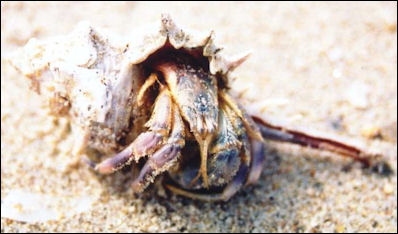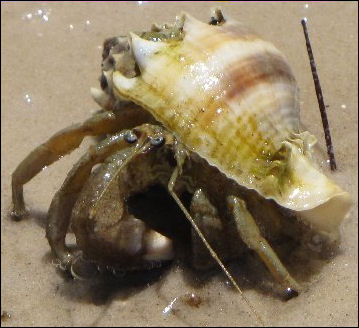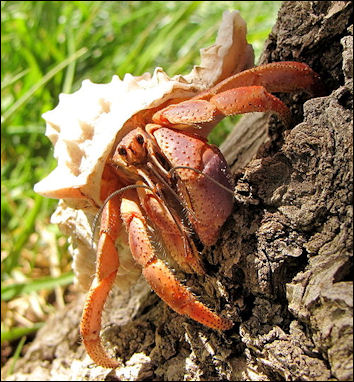Home | Category: Crustaceans (Crabs, Lobsters and Shrimp)
HERMIT CRABS

Hermit crab Hermit crabs are not “true crabs” in that they lack a hard protective shell. They have a long abdomen, which is soft and spiral shaped. They place their abdomen in an empty gastropod shell and anchor themselves to it with hooks on a pair of leglike organs. “True Crabs” are decapod crustaceans of the infraorder Brachyura, Hermit crabs are anomuran decapod crustaceans of the superfamily Paguroidea.
Hermit crabs tend to live along shores of sandy or rocky coasts. They can be found both on the land in the water. Land hermit crabs are often bigger than ones that spend most of their time in the water. Hermit crabs in mangroves spend a lot of their time on land near their burrows. Once a year they migrate en mass to the sea to breed. Females lay thousands of eggs in the sea that hatch into larvae that spend six weeks in the water before coming on land.
Common hermit crabs (Scientific name: Pagurus bernhardus) are found on the shores of the North Atlantic of northwestern Europe, from the White Sea to the British Isles, including the North, Baltic, and Barents Seas. They are found as far south as Portugal, the Mediterranean Sea, and the Azores. [Source: Kathleen Wang, Animal Diversity Web (ADW)]
Hermit crabs live along coasts in most types of seabeds, including rocky and shell bottoms, in sea grass beds, and sandy or silty sediments, but not muddy bottoms. Larvae live mainly in pools and may be found under objects such as rocks and seaweed. Common hermit crabs are most often found at depths up to 80 meters (262 feet), although they may been observed at depths of 200 meters (656 feet). Smaller individuals tend live in shallower waters than larger individuals.
Common hermit crabs are known to live for up to four years in the wild. Shell selection, as well as molting, affects longevity. Molting has short-term benefits that include limb regeneration but long-term costs such as potential negative changes reproductive success, feeding and place in the social hierarchy. Common hermit crabs have little impact on humans other than providing a source of amusement. Not very many people eat them. Some people keep them in aquariums and use them as fishing bait. Most hermit crab species has not yet been evaluated by the International Union for Conservation of Nature (IUCN), Convention on International Trade in Endangered Species (CITES) or any other agency.
Related Articles: Category: CRUSTACEANS (CRABS, LOBSTERS AND SHRIMP) ioa.factsanddetails.com; CRUSTACEANS: CHARACTERISTICS, KINDS AND ODD DEEP SEA ONES ioa.factsanddetails.com ; CRABS: CHARACTERISTICS, BEHAVIOR, MATING ioa.factsanddetails.com ; CRAB SPECIES ioa.factsanddetails.com ; GIANT JAPANESE SPIDER CRABS AND RED KING CRABS ioa.factsanddetails.com ; FIDDLER CRABS: CHARACTERISTICS, CLAWS AND BURROWS ioa.factsanddetails.com ; COCONUT CRABS — THE WORLD’S LARGEST TERRESTRIAL ARTHROPODS AND INVERTEBRATES ioa.factsanddetails.com ; HORSESHOE CRABS: CHARACTERISTICS, BLUE BLOOD, MATING AND MEDICINE ioa.factsanddetails.com
Websites and Resources: Animal Diversity Web (ADW) animaldiversity.org; National Oceanic and Atmospheric Administration (NOAA) noaa.gov; Fishbase fishbase.se ; Encyclopedia of Life eol.org ; Smithsonian Oceans Portal ocean.si.edu/ocean-life-ecosystems
Hermit Crab Physical Characteristics

Hermit crab in crown conch Most hermit crab species have long, spirally curved abdomens, which are soft, unlike the hard, calcified abdomens of other crabs and related crustaceans. The vulnerable abdomen is protected from predators by a salvaged empty seashell carried by the hermit crab, into which its whole body can retract. [Source: Wikipedia]
Hermit crab bodies are divided into two segments: cephalothorax and abdomen. The cephalothorax is encased by a carapace consisting of three thick cuticle layers: epicuticle, exocuticle, and endocuticle. The abdomen is soft and coiled to the right and body color is typically reddish or brown. Common hermit crabs are relatively large. The body has a maximum length of 8 centimeters (3.2 inches) and their carapace has a maximum length of 4.5 centimeters 1.8 inches). They range mass from 0.13 to 54 grams (1.90 ounces). Their average mass is 7.3 grams. [Source: Kathleen Wang, Animal Diversity Web (ADW)]
Hermit crabs have 5 pairs of walking legs; the first pair are enlarged claws (known as chelae). The chelae of males are often larger than those of females. Chelae are used for gathering food and for protection. Of the two claws, one is larger and is covered by an operculum; this claw is used in fighting and defense. Chelae and walking leg surfaces are rough. Common hermit crabs have compound eyes and four short antennae. Their last two pairs of walking legs are greatly reduced. They are used to hold the shell in place.
Hermit Crab Behavior
Hermits tend to be most active at night. They can be both solitary and social and have dominance hierarchies (ranking systems or pecking orders among members of a long-term social group, where dominance status affects access to resources or mates). Studies of common hermit crabs have shown that individuals may move within a range of 16-312 meters per month. Males and females communicate with each other through touch, visual cues and chemical signaling, and visual cues are used during aggressive encounters. [Source: Kathleen Wang, Animal Diversity Web (ADW)]
Common hermit crabs aggregate into loose communities, living around each other but not necessarily interacting. In these groups, breeding occurs at almost any time during the year and there is usually intense competition over resources, often resulting fighting and injuries. Each community has a dominant male. He is the one who wins the most fights and may assert its dominance by taking resources from others.
Caribbean hermit crab According to Animal Diversity Web: Before any physical encounter, Common hermit crabs engage in visual displays. During aggressive encounters, they either raise their bodies high off the ground, displaying their claws and walking legs, or lower their bodies in submission. If neither individual submits, the crabs may try to dislodge each other from their shells, an interaction known as shell fighting. One hermit crab will crawl onto its opponent's shell, hitting its opponents entire body, including its shell, and using its claws to rap its opponent's shell (over 500 raps have been observed in a single encounter). Around half of such encounters result in the aggressor exchanging shells with its opponent. Larger crabs, and those with larger claws, are usually more successful than small- and medium-sized crabs in these encounters.
Hermit Crabs and Their Shells
Hermit crabs make their homes in whelks, winkles, snails and other single-shell mollusks (gastropods). An individual crab snags the shell by curling it soft rear end into the spiral tunnel of the shell. It can withdraw into the shell, closing of the entrance if necessary with its claws. The tip of the hermit crab's abdomen is adapted to clasp strongly onto the columella of a snail shell.
Hermit crabs walk around, dragging their shells behind them. When they grow too large for their shell they move to a new shell. Sponges sometimes make their homes on the shells of hermit crabs. feeding on the remains of the crab's meals and adding to the crab's disguise. Sometime worms take up permanent residence in the shells and snatch food from the hermit crab's claw when the crab is eating. It is not unusual for sea anemones to hitch rides on the shell. These keep predators of the crab away. When the crab changes shells it sometimes lifts the anemone with its claws to the new shell. In the Indian Ocean there are hermit crabs that carry sea anemones on each claw.
Most frequently, hermit crabs use the shells of sea snails but individuals have been observed using the shells of bivalves (clams and scallops) and even hollow pieces of wood and stone. Common hermit crabs inhabit the abandoned shells of edible periwinkles, flat periwinkles, dog whelks and other whelks. Compared to most hermit crabs, common hermit crabs prefer a lighter shell. The size of the shell is important. If the shell is too large does it doesn’t offer the best protection (maybe a predator can get inside). If it is too small it restricts its growth. Individual hermit crabs sometimes attack others in attempts to claim ownership of their shell. [Source: Kathleen Wang, Animal Diversity Web (ADW)]
Shell selection has been extensively studied. According to Animal Diversity Web: Common hermit crabs are more likely to exchange and fight over shells when a new shell confers an advantage, such as more space. They are also able to remember shells that they have rejected before. If a crab is naked or in a shell that does not offer enough protection or space, then it will make the decision to move into a shell very quickly, regardless of advantages it may confer. If a new shell is of a much higher quality than the currently inhabited shell, the decision to move will also be made very quickly.
Study Suggest Hermit Crabs 'Feel and Remember Pain'
In 2009, researchers published the results of a study using mild electric shocks that suggests that hermit crabs feel and remember pain. The study was carried out by Professor Bob Elwood and Mirjam Appel from the School of Biological Sciences at Queen' University and was published in the journal "Animal Behaviour." Professor Elwood had similar work with prawns and other kinds of crabs. [Source: CNN, March 27, 2009]
CNN reported: In the research, wires were attached to the hermit crab’s shells to deliver small shocks to the abdomen of some of the crabs within the shells. The only crabs to get out of their shells were those which had received shocks, indicating that the experience was unpleasant for them. The research suggests that this response is not just a reflex, but that central neuronal processing takes place. Hermit crabs are known to prefer some species of shells to others and it was found that that they were more likely to come out of the shells they least preferred.
The main aim of the experiment was to deliver a shock just under the threshold that causes crabs to move out of the shell, to see what happened when a new shell was then offered. Crabs that had been shocked but had remained in their shell appeared to remember the experience of the shock because they quickly moved towards the new shell, investigated it briefly and were more likely to change to the new shell compared to those that had not been shocked.
"There has been a long debate about whether crustaceans including crabs, prawns and lobsters feel pain," Elwood said. "We know from previous research that they can detect harmful stimuli and withdraw from the source of the stimuli but that could be a simple reflex without the inner 'feeling' of unpleasantness that we associate with pain. This research demonstrates that it is not a simple reflex but that crabs trade-off their need for a quality shell with the need to avoid the harmful stimulus.” Elwood then went on to argue that protection and consideration has to given to the billions of crustaceans used in food industry each year.
Hermit Crab Food, Predators and Ecosystem Roles
Hermit crabs are omnivores (eat both plants and animals) and scavengers. Common hermit crabs exploit a wide variety of food sources: pieces of dead animals, microscopic bivalves, marine worms, detritus, aquatic crustaceans, plants and decayed plant material. Cannibalistic has been observed when resources are scarce. Their eating strategies make sense for for survival in environments that are unpredictable and vary a great deal according to seasons. [Source: Kathleen Wang, Animal Diversity Web (ADW)]
Predators of common hermit crabs include fishes, starfish, octopi, other crabs, and some birds. Seagulls are known to pick up common hermit crabs in their beaks and drop them on rocks to break their shells.
Common hermit crabs play important roles local ecosystems as scavengers and detritovores (consumers of dead plant and animal material). As detritovores, they help decompose and recycle nutrients. Their shells provide residences for protozoans, hydrozoans, entroprocts, barnacles, and polychaete worms and Some epibionts, such as sea anenomes, make their home on the shells and may help protect the hermit crab from predators.
Hermit Crab Mating and Reproduction
Hermit crabs are oviparous (young are hatched from eggs) and iteroparous (offspring are produced in groups). They engage in internal reproduction in which sperm from the male parent fertilizes an egg from the female parent. Hermit crabs engage in both seasonal breeding and year-round breeding. Common hermit crabs breed multiple times throughout the year. Populations living in deeper waters breed year round, while those living in shallower waters tend to breed in January and February. The number of eggs ranges from 200 to 300, with up to 30 percent being lost or destroyed. The average gestation period is 43 days. The average age at sexual maturity for both females and males is one year. [Source: Kathleen Wang, Animal Diversity Web (ADW)]
Hermit crabs are polygynandrous (promiscuous), with both males and females having multiple partners. Unlike many species of crabs, copulation does not necessarily follow a female's molting. According to Animal Diversity Web: Before copulation, a male carries or pulls a female around by her shell opening for hours, even days in some cases, using his minor claw. Just prior to copulation, he holds her by one of her right walking legs, pulling her toward him and tapping her appendages with his major claw. This is followed by a period where both male and female tap each other with their claws (the female also palpates the male's mouthparts) for 15-20 minutes. When a female is ready to mate, she gives either a tactile or chemical signal, causing a male to turn her around to face him. Both individuals leave their shells and copulate for 4-6 minutes. They remain together, outside of their shells, for up to 10 minutes after copulation.
Among common hermit crabs there has documentation of breeding occurring during all phases of a female molt cycle. There are many environmental factors that affect whether or not mating occurs, such as time of the day, water temperature, air temperature, salinity, and availability of resources.
Hermit Crab Development
After fertilization, a female carries eggs until they hatch (the 43 day gestation period). During this time, they exhibit greater care in shell choice, switching shells more often than when they are not brooding. [Source: Kathleen Wang, Animal Diversity Web (ADW)]
Common hermit crab eggs are black in color. After they hatch, larvae pass through four zoeal stages and a glaucothoe-megalopa stage before reaching adulthood. Zoeal stages take 39-47 days to complete, with the megalopa stage requiring an additional 13 days on average; total development time averages 60 days. Zoeal larvae are thin, long, and yellowish-red in color. More chromatophores are added in each stage of zoeal development: megalops have areas of red and pale-yellow coloration and adults are reddish-brown.
Common hermit crab megalops do not eat and must seek out a suitable shell in which to complete metamorphosis. Shell type and size effectively determine survival odds, as well as body size, time to sexual maturity, and longevity. Sexual differentiation occurs during the zoeal stages; female development is complete upon reaching adulthood, while males continue to develop morphological characteristics after adulthood. Sexual maturity is typically reached within a year.
Image Sources: Wikimedia Commons, NOAA
Text Sources: Animal Diversity Web (ADW) animaldiversity.org; National Oceanic and Atmospheric Administration (NOAA) noaa.gov; Wikipedia, National Geographic, Live Science, BBC, Smithsonian, New York Times, Washington Post, Los Angeles Times, The New Yorker, Reuters, Associated Press, Lonely Planet Guides and various books and other publications.
Last Updated April 2023

